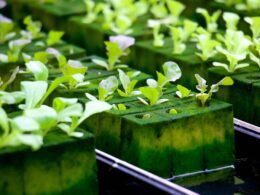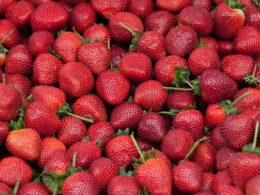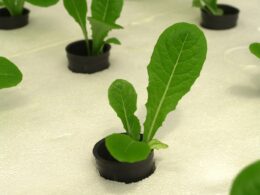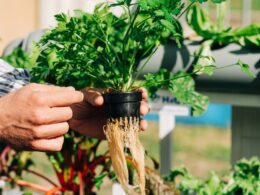Are you wondering whether or not you should cut yellow leaves off your plants? The answer may not be as straightforward as you think. While yellow leaves can be a sign of a problem with your plant, they don’t always need to be removed. In fact, cutting off too many leaves can actually harm your plant.
In this article, we’ll explore the reasons why leaves turn yellow, the benefits and drawbacks of pruning yellow leaves, when to prune them, and alternatives to pruning. By the end, you’ll have a better understanding of how to keep your plants healthy and happy.
Taking care of plants can be a daunting task, but it can also be rewarding and fulfilling. However, it’s important to know what you’re doing to ensure your plants thrive. Yellow leaves are a common occurrence, but they can be a sign of a problem or simply a natural part of your plant’s growth cycle.
Knowing when and how to prune yellow leaves can make all the difference in keeping your plant healthy and strong. So, let’s dive in and explore the world of yellow leaves and pruning!
Understanding Why Leaves Turn Yellow
Understanding the natural process behind the discoloration of leaves to a yellow hue is essential for proper plant care. Preventing yellow leaves is one of the primary concerns for plant enthusiasts.
Yellowing is usually a sign of a problem, and it could mean that your plant isn’t getting enough nutrients or water. One of the most common causes of yellowing is overwatering. When there’s too much water in the soil, the roots can’t breathe, and the plant can’t absorb nutrients. This can lead to yellow leaves and even root rot.
Another common cause of yellowing is nutrient deficiency. Plants need a balanced mix of nitrogen, phosphorus, and potassium to thrive. If your plant isn’t getting enough of any of these nutrients, it’ll start to show signs of yellowing.
In summary, understanding the common causes of yellowing is the first step in preventing yellow leaves. Proper watering and nutrient management are essential for healthy plants. If you notice yellowing, it’s important to identify the cause and take action to correct the problem. By doing so, you can help your plant thrive and enjoy its natural beauty for years to come.
Benefits and Drawbacks of Pruning Yellow Leaves
Trimming away dying foliage can be a double-edged sword, as it can stimulate growth while also leaving behind a stark reminder of lost potential. When it comes to yellow leaves on plants, there are both pros and cons to pruning them off.
On one hand, removing yellow leaves can improve the appearance of the plant and prevent the spread of diseases. On the other hand, yellow leaves can still contribute to the plant’s overall health by providing nutrients and energy to the rest of the plant.
Effectiveness and results also vary depending on the plant species and the severity of the yellowing. In some cases, removing yellow leaves may do more harm than good, as it can cause stress to the plant and slow down growth. In other cases, pruning yellow leaves may be necessary for the plant’s survival, especially if the yellowing is caused by a disease or pest infestation.
Ultimately, the decision to prune yellow leaves off a plant should be made on a case-by-case basis, taking into account the plant’s overall health and the severity of the yellowing. If you do decide to prune yellow leaves, make sure to use clean, sharp scissors or pruning shears to prevent further damage to the plant.
Remember, while removing yellow leaves can improve the appearance of the plant, it may not always be the best choice for the plant’s long-term health.
When to Prune Yellow Leaves
When it comes to pruning yellow leaves, timing and frequency are important factors to consider. Knowing when to prune can help ensure the health and growth of your plants. Additionally, using the proper tools and techniques can make the process easier and more effective.
Lastly, don’t forget to dispose of the pruned leaves properly to prevent the spread of disease or pests.
Timing and Frequency
Knowing the optimal time and frequency for leaf maintenance can make all the difference in keeping your plants healthy. Pruning frequency and optimal timing are the keys to ensuring that your plants thrive. The following tips will help you achieve this:
• Don’t prune your plant’s leaves too frequently, as this can cause stress and damage to the plant. Instead, wait until you see yellow leaves and then prune them off.
• Prune your plant’s leaves at the optimal time, which is usually in the morning or evening when the sun isn’t too strong.
• Be mindful of the type of plant you have and its specific needs. Some plants may require more frequent pruning than others.
• Remember to never remove more than 25% of a plant’s foliage at one time, as this can cause stress and damage to the plant.
By following these simple guidelines, you can ensure that your plants stay healthy and vibrant. Keep in mind that pruning yellow leaves off your plants is an important part of their maintenance, but it should be done with care and consideration for the plant’s needs.
With the right timing and frequency, your plants will continue to thrive and bring beauty and life to your home.
Tools and Techniques
Let’s explore some tools and techniques that’ll help keep your plants healthy and looking their best.
When it comes to pruning yellow leaves, it’s important to have the right tools on hand. A sharp pair of pruning shears is essential for making clean cuts that won’t damage the plant. Make sure to clean and sharpen your shears regularly to prevent the spread of disease.
When it comes to pruning techniques, it’s best to start at the base of the leaf stem and cut as close to the main stem as possible. Avoid leaving any stubs, as this can lead to rot and disease. It’s also important to only remove yellow leaves that are completely dead or dying, as removing healthy leaves can stress the plant and stunt its growth.
Lastly, always remember to take safety precautions when pruning, such as wearing gloves and eye protection, and be mindful of your surroundings.
By following these tips, you can help keep your plants healthy and thriving.
Proper Disposal of Pruned Leaves
Make sure to dispose of pruned leaves properly to prevent the spread of disease and keep your garden healthy and beautiful. Although it may be tempting to simply throw them in the trash or leave them on the ground, these options can lead to the spread of harmful pathogens and pests.
Instead, consider composting your pruned leaves to create a nutrient-rich soil amendment for your garden. Composting options include creating a compost pile in your backyard, using a compost bin, or taking your pruned leaves to a community composting facility.
By composting your pruned leaves, you’re not only preventing the spread of disease but also reducing your environmental impact by keeping organic matter out of landfills. Make sure to research eco-friendly disposal options in your area to ensure that your pruned leaves are being disposed of properly.
Alternatives to Pruning Yellow Leaves
If you’re hesitant to prune yellow leaves off your plants, don’t worry! There are alternatives that can address the underlying issues causing the yellowing.
First, try adjusting your watering habits to ensure your plants aren’t getting too much or too little water.
Next, fertilize your plants to address any nutrient deficiencies that may be causing the yellowing.
Lastly, if your plant is suffering from a pest or disease infestation, treat it promptly to prevent further damage.
Adjusting Watering Habits
By adjusting how much water your plants receive, you can keep them healthy and vibrant. Overwatering can lead to root rot, which in turn causes yellow leaves. On the other hand, underwatering can also cause yellow leaves due to a lack of nutrients reaching the leaves.
Here are three steps to adjust your watering habits and avoid yellow leaves:
-
Check the soil quality regularly. Stick your finger an inch or two into the soil to see if it’s dry or moist. If it’s dry, it’s time to water. If it’s moist, wait a day or two before watering.
-
Adjust the watering frequency based on the plant’s needs. Some plants need more water than others, and some require less frequent watering. Do some research on your specific plants to determine their ideal watering schedule.
-
Use the right amount of water. Aim to water the soil evenly until it’s moist but not soaking wet. Avoid letting water sit in the saucer, as this can lead to root rot.
By following these steps, you can ensure your plants receive the right amount of water and avoid yellow leaves caused by over or under watering. Remember, healthy leaves start from healthy roots, and adjusting your watering habits can help keep your plants thriving.
Fertilizing to Address Nutrient Deficiencies
Fertilizing is an effective way to address nutrient deficiencies and promote healthy growth in plants. If you notice yellowing leaves on your plants, it could be a sign of nutrient deficiency. In this case, fertilizing with the right nutrients can help improve the plant’s health.
When it comes to choosing fertilizers, you can opt for organic or chemical fertilizers. Organic fertilizers are made from natural ingredients and are considered safer for the environment and your plants. Chemical fertilizers, on the other hand, are made from synthetic ingredients and provide a quick fix to nutrient deficiencies.
Another factor to consider is soil pH and nutrient uptake. Some nutrients are better absorbed by plants in acidic soil, while others thrive in alkaline soil. It’s important to test your soil’s pH and choose a fertilizer that is tailored to the specific needs of your plants.
Treating Pest or Disease Infestations
Now that you know how to address nutrient deficiencies by fertilizing your plants, let’s talk about another common issue: pest or disease infestations.
You may have noticed yellow leaves on your plants, but it’s important to determine the cause before cutting them off. Yellow leaves can be a sign of a pest or disease infestation, so it’s important to address the root of the problem.
Integrated pest management is a holistic approach to managing pest problems that focuses on prevention and using natural remedies. Here are some tips for treating pest or disease infestations:
-
Identify the pest or disease: It’s important to know what you’re dealing with in order to choose the most effective solution.
-
Use natural remedies: Chemical pesticides can harm beneficial insects and have negative effects on the environment. Instead, try using natural remedies such as neem oil, insecticidal soap, or companion planting.
-
Practice good plant hygiene: Keep your plants healthy by removing dead or diseased leaves, and avoid overwatering or overcrowding plants.
By following these tips and using integrated pest management, you can address pest or disease infestations without harming your plants or the environment.
Tips for Keeping Your Plants Healthy and Happy
Make sure your plants are thriving by following these tips that will keep them healthy and happy.
First, consider container gardening if you don’t have a lot of outdoor space. Container gardening allows you to grow plants in smaller spaces and is a great alternative to traditional gardening.
Additionally, using natural pest control methods can help to keep your plants healthy and free from harmful chemicals.
Another tip for keeping your plants healthy and happy is to make sure they have proper drainage. Overwatering can lead to root rot and other issues, so it’s important to ensure that excess water is able to drain away easily. You can also add a layer of mulch to help retain moisture in the soil and prevent it from drying out too quickly.
Lastly, pay attention to your plants and give them the care they need. This means regularly checking for any signs of pest or disease infestations, pruning as necessary, and providing proper sunlight and water.
By taking these steps, you can help your plants to thrive and ensure that you have a beautiful and healthy garden.
Frequently Asked Questions
Can yellow leaves ever turn green again, or are they permanently damaged?
If you’re noticing yellow leaves on your plants, it’s natural to wonder if they can be saved. The answer is – it depends.
Some plants, like succulents, have natural yellowing as part of their growth cycle and don’t need any intervention. However, if the yellowing is due to pests, disease, or overwatering, it’s important to address those issues first.
Once the underlying cause is resolved, the plant may still be able to recover. Some species, like tomatoes and peppers, can even turn yellow leaves green again with proper care. This may involve adjusting the watering schedule, providing enough sunlight, and fertilizing with the appropriate nutrients.
However, if the leaves are severely damaged or dead, they won’t turn green again. In these cases, it’s best to remove them to prevent the plant from wasting energy on them.
Overall, the key is to identify the cause of yellowing leaves and take action accordingly.
Will cutting off yellow leaves cause the plant to produce more leaves or flowers?
If you want your plants to produce more leaves or flowers, cutting off yellow leaves may not be the best solution. While removing dead or yellowing leaves can improve the appearance of your plant, it doesn’t necessarily stimulate growth.
Instead, focus on the effectiveness of fertilizers and the timing of pruning to encourage healthy growth. Fertilizers can provide essential nutrients that your plant needs to thrive, while pruning at the right time can promote new growth and increase flower production.
So, if you want to see more leaves or flowers on your plants, consider using fertilizers and pruning strategically rather than simply cutting off yellow leaves.
Is it safe to eat fruits or vegetables from a plant with yellowing leaves?
Eating fruits or vegetables from a plant with yellowing leaves might not be the safest option. The effects of yellow leaves on plant growth can lead to a decrease in the plant’s ability to produce nutrients and fight off diseases.
Preventing yellow leaves on plants is essential for ensuring that the plant is healthy and producing nutritious fruits and vegetables. One way to prevent yellow leaves is by providing adequate water and nutrients to the plant. Additionally, removing any dead or diseased leaves can prevent the spread of diseases and promote healthy growth.
So, before you decide to eat from a plant with yellowing leaves, consider the potential risks and take steps to prevent them.
Can overwatering or underwatering cause yellow leaves, and how can I tell the difference?
Are your plant’s leaves turning yellow? It could be due to overwatering or underwatering. Identifying the cause is crucial to prevent further damage.
Overwatering can cause yellow leaves, but so can underwatering. To tell the difference, check the soil moisture level. If the soil is waterlogged, you’re overwatering. If the soil is dry, you’re underwatering.
Prevention tips for yellowing leaves include watering your plants only when the soil is dry, providing proper drainage, using a well-balanced fertilizer, and ensuring adequate sunlight.
Remember, cutting yellow leaves off plants isn’t always necessary, so identifying the underlying cause is key to keeping your plants healthy.
If I don’t prune yellow leaves, will they eventually fall off on their own?
When you notice yellow leaves on your plants, it’s important to identify the cause before deciding whether or not to prune them.
Yellow leaves can be a sign of various issues, such as overwatering, underwatering, nutrient deficiencies, pests, or diseases. If the underlying problem is not resolved, cutting off the yellow leaves may not be enough to save the plant.
Additionally, removing too many leaves can stress the plant and hinder its growth. However, if the yellow leaves are severely damaged or infected, removing them can prevent the spread of the problem to other parts of the plant.
Ultimately, the effects of yellow leaves on plant growth depend on the cause and severity of the issue. So, before taking action, make sure to investigate the problem and address it accordingly.
Conclusion
So, should you cut yellow leaves off plants? It depends on the situation. Yellow leaves can be a sign of a problem, such as nutrient deficiency or disease, but they can also be a natural part of a plant’s growth cycle.
Pruning yellow leaves can have benefits, such as improving appearance and directing the plant’s energy to healthier parts, but it can also have drawbacks, such as removing valuable nutrients and stressing the plant.
Ultimately, the best course of action is to understand why your plant’s leaves are turning yellow and address the underlying issue. If pruning is necessary, do so sparingly and at the appropriate time.
Remember to also consider alternatives to pruning, such as adjusting watering or fertilizing habits. By taking care of your plants and being mindful of their needs, you can keep them healthy and happy for years to come.









